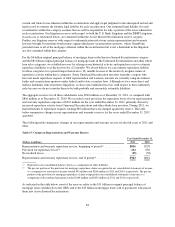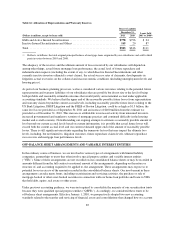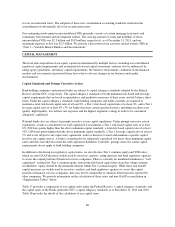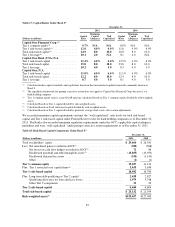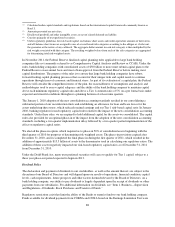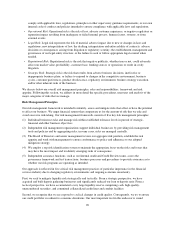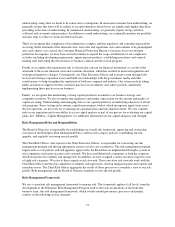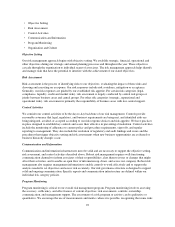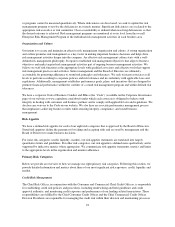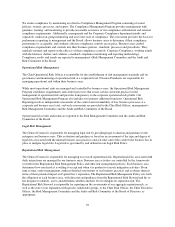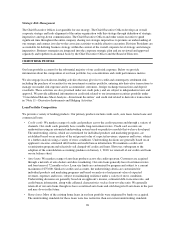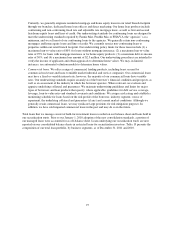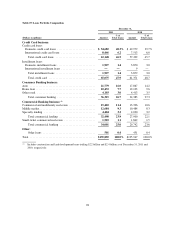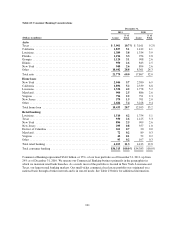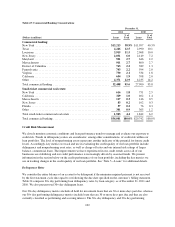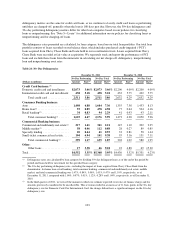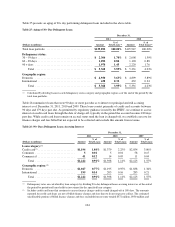Capital One 2011 Annual Report Download - page 114
Download and view the complete annual report
Please find page 114 of the 2011 Capital One annual report below. You can navigate through the pages in the report by either clicking on the pages listed below, or by using the keyword search tool below to find specific information within the annual report.to control credit risk and comply with credit policies and guidelines. In addition, the Chief Risk Officer
establishes policies, delegates approval authority and monitors performance for non-loan credit exposure entered
into with financial counterparties or through the purchase of credit sensitive securities in our investment
portfolio.
Our credit policies establish standards in five areas: customer selection, underwriting, monitoring, remediation,
and portfolio management. The standards in each area provide a framework comprising specific objectives and
control processes. These standards are supported by detailed policies and procedures for each component of the
credit process. Starting with customer selection, our goal is to provide credit on terms that generate above hurdle
returns. We use stress tests in conjunction with our planning process to establish specific limits to help us achieve
that goal.
We apply quantitative credit risk limits and guidelines to each of our lines of business. We monitor performance
and forecasts relative to these guidelines and report results and any required mitigating actions to the Credit
Policy Committee and to the Audit and Risk Committee of the Board.
Liquidity Risk Management
The Chief Financial Officer is responsible for managing liquidity risk. We assess liquidity strength by evaluating
several different balance sheet metrics under severe stress scenarios to ensure we can withstand significant
funding degradation in both deposits and capital marketing funding sources. Management reports liquidity
metrics to the Asset/Liability Management Committee monthly and to the Finance and Trust Oversight
Committee of the Board of Directors no less than quarterly. Any policy breach in a liquidity limit is required to
be reported to the Treasurer as soon as it is identified and to the Asset/Liability Management Committee at the
next regularly scheduled committee meeting, unless the breach activates the Liquidity Contingency Plan, in
which case a special meeting may be called. Any policy breach is also required to be reported to the Finance and
Trust Oversight Committee no later than the next regularly scheduled meeting. Detailed processes, requirements
and controls are contained in our policies and supporting procedures.
Market Risk Management
The Chief Financial Officer is responsible for managing market risk. We manage market risk exposure centrally
and establish quantitative limits to control our exposure. We define market risk as the risk that our earnings and/
or economic value of equity may be adversely affected by changes in market conditions, including changes in
interest rates and foreign currency exchange rates, changes in credit spreads and price fluctuations and changes in
value due to changes in market perception or the actual credit quality of issuers. Market risk is inherent in the
financial instruments associated with our operations and activities, including loans, deposits, securities, short-
term borrowings, long-term debt and derivatives.
The market risk positions of our banking entities and the company are calculated separately and in total and are
reported in comparison to pre-established limits to the Asset/Liability Management Committee monthly and to
the Finance and Trust Oversight Committee of the Board no less than quarterly. Management is authorized to
utilize financial instruments as outlined in our policy to actively manage market risk exposure. Detailed
processes, requirements and controls are contained in our policies and supporting procedures.
Compliance Risk Management
The Chief Compliance Officer is responsible for establishing the compliance management program, for
determining specific compliance requirements, and for monitoring performance. Division Presidents are
responsible for building and maintaining business processes that meet the requirements of the compliance
program.
94


